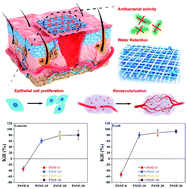Remodeling of inherent antimicrobial nanofiber dressings with melamine-modified fibroin into neoskin†
Abstract
Despite the fact that various antimicrobial approaches have been applied toward wound dressings, most of them are apt for complicated systems involving either the controllable delivery of antimicrobial agents or hierarchical structures of composite materials. Wound dressings produced by currently available methods suffer from several issues such as the emergence of drug-resistant bacteria, inconvenience of utilization, and enormous medical fees. In this study, a simple and effective antimicrobial polymer, namely, melamine-modified silk fibroin (SF–Mel), has been successfully synthesized and fabricated into a series of PCL/SF–Mel nanofiber films (PSNFs) via the electrospinning technique. A series of physicochemical characterizations of the electrospun PSNFs were performed. Moreover, the PSNFs not only exhibited worthwhile hemocompatibility and cytocompatibility, but also broad-spectrum antibacterial activities against both Gram-negative (Escherichia coli) and Gram-positive bacteria (Staphylococcus aureus). The in vivo evaluations of a full-thickness skin defect model further revealed that PSNFs could accelerate wound healing by promoting re-epithelialization, collagen deposition, and vascular reconstruction. Consequently, SF–Mel-based electrospun nanofiber films might be considered as an alternative for simple feasible wound dressings.



 Please wait while we load your content...
Please wait while we load your content...